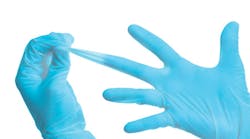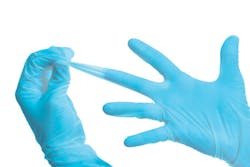Perfect fit for hand health: The selection of gloves should should be based on comfort and durability too
By Anne Guignon, RDH, MPH, CSP
While it might be hard for some people to imagine, health-care professionals started routinely wearing gloves only in the mid-1980s. The advent of HIV/AIDS during that time changed our work habits forever. It was hard for many health-care professionals to learn how to deliver clinical care with gloves on.
The early gloves fit poorly. They were either too small or too large. The finger length was often too short or too long. Those with wide hands suffered cramps and soreness. Others ended up with aching fingers and thumbs. The first exam gloves were thick, hot, and interfered with tactile sensitivity. Some clinicians experienced dermatitis issues directly related to the chemicals used in glove processing, and others developed allergic reactions to latex.
Latex was the only material readily available early on. Latex gloves stayed on because of compression, so essentially using a latex glove was like putting your hand in a rubber band. Ambidextrous latex gloves created an additional issue since the thumb was forced into the same geometric plane as the fingers. This increased thumb stress, and then the user had to push against the latex glove to maintain a pinch grip. The result was more work to an already overloaded thumb joint and surrounding muscles and nerves.
Powdered latex gloves were introduced to absorb excess skin moisture and aid in donning. But powder causes skin dryness and has been implicated in multiple issues in the surgical setting. The FDA is now accepting public comments and will most likely ban powdered gloves before the end of this year.
When it became clear that gloves were going to remain the standard of care, companies began to focus on manufacturing high quality gloves and poured money into research and development. The goal was to create a glove that would satisfy infection-control requirements without sacrificing comfort or leading to dermatitis issues. Many health-care workers wear gloves for only a short period of time, such as the few minutes it takes to draw blood or take a patient's vital signs. Dental offices are different. We wear gloves for long periods of time, so fit is critical.
We also want low failure rates in our gloves. Tensile strength, elasticity, and pinhole defects contribute to overall glove integrity. While American Society for Testing and Materials (ASTM) rates are voluntary, they meet the FDA-regulatory guidelines for gloves. Gloves that meet or exceed ASTM standards are manufactured to have a high level of reliability, which leads to fewer torn gloves.
Glove checklist: Finding the perfect fit
- Finger length
- Palm width
- Length from fingertips to cuff
- Textured fingertips/palm
- Fabric comfort and feel
- Overall fit
- Consistent sizing
Dental professionals need affordable gloves that are thin, easy to don, do not lead to or aggravate dermatitis issues, don't stress delicate nerves or blood vessels, have low pinhole failure rates, and are kind to finger and thumb joints. This is a tall order! Two decades ago, Microflex embraced these challenges. Over the years the company has worked to develop high-quality gloves that meet these demands. Microflex also understands the value of independent research to substantiate their claims.
Five years ago, in a private meeting at the ADA in Las Vegas, Microflex asked me to test a new nitrile glove. I put my favorite glove at the time on one hand and then, with my eyes closed, put on the new one. My response was instant. The XCEED glove was thin, soft, felt good, fit well, and allowed a full range of motion! One year later, Microflex launched UltraForm, which is even thinner and more flexible and came 300 gloves to a box.
Several years ago, Microflex introduced Neogard, a new polychloroprene glove. Neogard approximates the fit and feel of latex without all of the downsides of natural rubber. Neogard performs especially well during long, wet procedures by reducing the pinch grip associated with other glove materials.
When it was apparent XCEED gloves were more comfortable, Microflex wanted scientific proof that the gloves could contribute to hand health. US Ergonomics, an independent testing firm based in New Jersey, created a rigorous testing protocol. The ergonomic testing included having practicing dental hygienists perform tasks with and without gloves in both dry and wet conditions. The goal was to compare performance and muscle activity while gloved as compared to barehanded.
The US Ergonomics tests evaluated muscle effort and performance for postural and gripping tasks involving a mouth mirror. The results were stunning. When compared to bare hands, XCEED provided the same level of muscle effort for postural tasks, and performing the postural and gripping tasks wearing Ultraform was the same as doing the tasks without gloves. Neogard gloves have also gone through testing. All three brands are the first and only gloves to hold an ergonomic certification from US Ergonomics, and Neogard also has a wet grip certification.
Even though there are a small number of health-care professionals that still develop dermatitis issues from today's nitrile gloves, Microflex and its parent company, Ansell, have addressed these issues. The Sensation and NitraFree brands undergo a different manufacturing process for those who are extraordinarily sensitive to the chemicals used in glove processing.
While many clinicians are lucky enough to be able to use a glove that fits their hands well, there are those who are expected to use whatever product their office supplies, whether or not it's comfortable or kind to one's skin. Research has shown that it's bad for the practice's income to wear the wrong size of glove, since it takes 7% to 10% longer to perform a task while wearing an improperly fitted glove. But if you must, a large glove is better than one that's too small.
Since we spend hours every day wearing gloves, it's important to find the right fit. Large dental meetings often have many vendors, making it easy to compare brands, but the real proof is how the glove feels patient after patient. Ansell has simplified this process by making it easy to order glove samples online. Samples of XCEED, Ultraform, and Neogard are available at ansell.com/ErgoSense. Sensation and NitraFree samples can be ordered at ansell.com/HandFriendly. Type in your contact information, which gloves you want to sample, and the appropriate size. Now you can test premium gloves that support your hand health.
If you or your officemates want to learn even more about gloves and earn one free CE, visit INeedCE.com. Scroll down and click on the course title, "Spotlight on Hand Health: How Quality Gloves Protect One of Your Most Critical Physical Tools." In less than an hour you'll learn more about gloves than you ever thought possible. Wearing the right glove makes sense for your hand health from an infection control standpoint. Inexpensive, poorly made gloves are just not worth the risk. RDH
ANNE NUGENT GUIGNON, RDH, MPH, CSP, provides popular programs, including topics on biofilms, power driven scaling, ergonomics, hypersensitivity, and remineralization. Recipient of the 2004 Mentor of the Year Award and the 2009 ADHA Irene Newman Award, Anne has practiced clinical dental hygiene in Houston since 1971, and can be contacted at [email protected].







